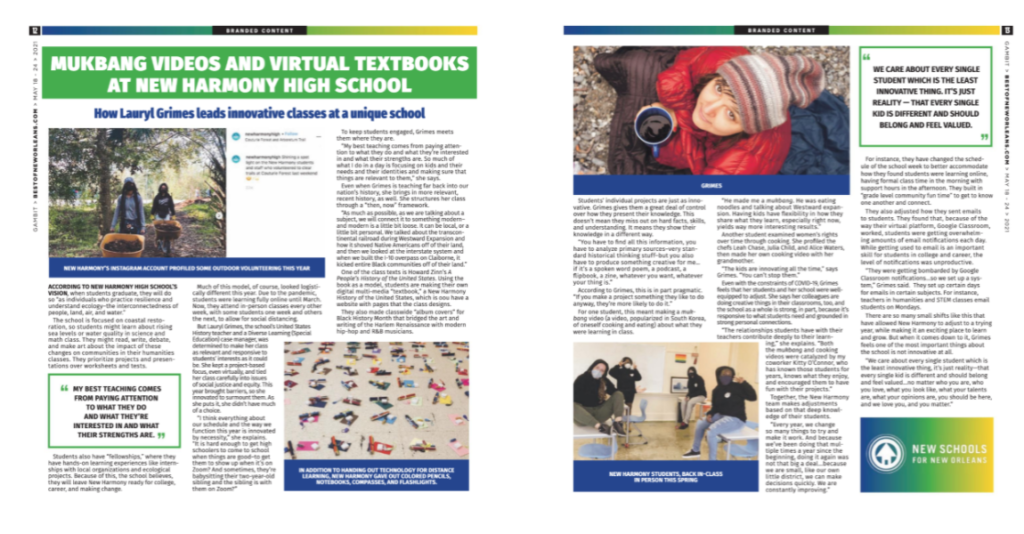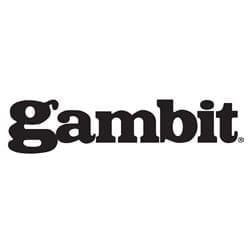The May 18th issue of Gambit included the following sponsored article featuring New Harmony High School and their innovative classes led by teacher Lauryl Grimes.

Mukbang Videos and Virtual Textbooks at New Harmony High School
How Lauryl Grimes leads innovative classes at a unique school
According to New Harmony High School’s vision, when students graduate, they will do so “as individuals who practice resilience and understand ecology–the interconnectedness of people, land, air, and water.”

New Harmony’s Instagram account profiled some outdoor volunteering this year.
The school is focused on coastal restoration, so students might learn about rising sea levels or water quality in science and math class. They might read, write, debate, and make art about the impact of these changes on communities in their humanities classes. They prioritize projects and presentations over worksheets and tests.
Students also have “fellowships,” where they have hands-on learning experiences like internships with local organizations and ecological projects. Because of this, the school believes, they will leave New Harmony ready for college, career, and making change.
Much of this model, of course, looked logistically different this year. Due to the pandemic, students were learning fully online until March. Now, they attend in-person classes every other week, with some students one week and others the next, to allow for social distancing.

In addition to handing out technology for distance learning, New Harmony gave out colored pencils, notebooks, compasses, and flashlights.
Lauryl Grimes, the school’s United States History teacher and a Diverse Learning (Special Education) case manager, was determined to make her class as relevant and responsive to students’ interests as it could be. She kept a project-based focus, even virtually, and tied her class carefully into issues of social justice and equity. This year brought barriers, so she innovated to surmount them. As she puts it, she didn’t have much of a choice.
“I think everything about our schedule and the way we function this year is innovated by necessity,” she explains. “It is hard enough to get high schoolers to come to school when things are good–to get them to show up when it’s on Zoom? And sometimes, they’re babysitting their two-year-old sibling and the sibling is with them on Zoom?”
To keep students engaged, Grimes meets them where they are.
“My best teaching comes from paying attention to what they do and what they’re interested in and what their strengths are. So much of what I do in a day is focusing on kids and their needs and their identities and making sure that things are relevant to them,” she says.
Even when Grimes is teaching far back into our nation’s history, she brings in more relevant, recent history, as well. She structures her class through a “then, now” framework.
“As much as possible, as we are talking about a subject, we will connect it to something modern–and modern is a little bit loose. It can be local, or a little bit personal. We talked about the transcontinental railroad during Westward Expansion and how it shoved Native Americans off of their land, and then we looked at the interstate system and when we built the I-10 overpass on Claiborne, it kicked entire Black communities off of their land.”
One of the class texts is Howard Zinn’s A People’s History of the United States. Using the book as a model, students are making their own digital multi-media “textbook,” a New Harmony History of the United States, which is a website with pages that the class designs.
They also made classwide “album covers” for Black History Month that bridged the art and writing of the Harlem Renaissance with modern hip-hop and R&B musicians.

Student “album cover” bridging Lauryn Hill and Langston Hughes
Students’ individual projects are just as innovative. Grimes gives them a great deal of control over how they present their knowledge. This doesn’t mean they miss out on hard facts, skills, and understanding. It means they show their knowledge in a different way.
“You have to find all this information, you have to analyze primary sources–very standard historical thinking stuff–but you also have to produce something creative for me… if it’s a spoken word poem, a podcast, a flipbook, a zine, whatever you want, whatever your thing is.”
According to Grimes, this is in part pragmatic. “If you make a project something they like to do anyway, they’re more likely to do it.”
For one student, this meant making a mukbang video (a video, popularized in South Korea, of oneself cooking and eating) about what they were learning in class.
“He made me a mukbang. He was eating noodles and talking about Westward expansion. Having kids have flexibility in how they share what they learn, especially right now, yields way more interesting results.”

New Harmony High School Teacher Lauryl Grimes
Another student examined women’s rights over time through cooking. She profiled the chefs Leah Chase, Julia Child, and Alice Waters, then made her own cooking video with her grandmother.
“The kids are innovating all the time,” says Grimes. “You can’t stop them.”
Even with the constraints of COVID-19, Grimes feels that her students and her school were well-equipped to adjust. She says her colleagues are doing creative things in their classrooms, too, and the school as a whole is strong, in part, because it’s responsive to what students need and grounded in strong personal connections.
“The relationships students have with their teachers contribute deeply to their learning,” she explains. “Both the mukbang and cooking videos were catalyzed by my coworker Kitty O’Connor, who has known those students for years, knows what they enjoy, and encouraged them to have fun with their projects.”
Together, the New Harmony team makes adjustments based on that deep knowledge of their students.
“Every year, we change so many things to try and make it work. And because we’ve been doing that multiple times a year since the beginning, doing it again was not that big a deal…because we are small, like our own little district, we can make decisions quickly. We are constantly improving.”
For instance, they have changed the schedule of the school week to better accommodate how they found students were learning online, having formal class time in the morning with support hours in the afternoon. They built in “grade level community fun time” to get to know one another and connect.

New Harmony students, back in-class in person this spring
They also adjusted how they sent emails to students. They found that, because of the way their virtual platform, Google Classroom, worked, students were getting overwhelming amounts of email notifications each day. While getting used to email is an important skill for students in college and career, the level of notifications was unproductive.
“They were getting bombarded by Google Classroom notifications…so we set up a system,” Grimes said. They set up certain days for emails in certain subjects. For instance, teachers in humanities and STEM classes email students on Mondays.
There are so many small shifts like this that have allowed New Harmony to adjust to a trying year, while making it an exciting place to learn and grow. But when it comes down to it, Grimes feels one of the most important things about the school is not innovative at all.
“We care about every single student which is the least innovative thing, it’s just reality—that every single kid is different and should belong and feel valued…no matter who you are, who you love, what you look like, what your talents are, what your opinions are, you should be here, and we love you, and you matter.”
